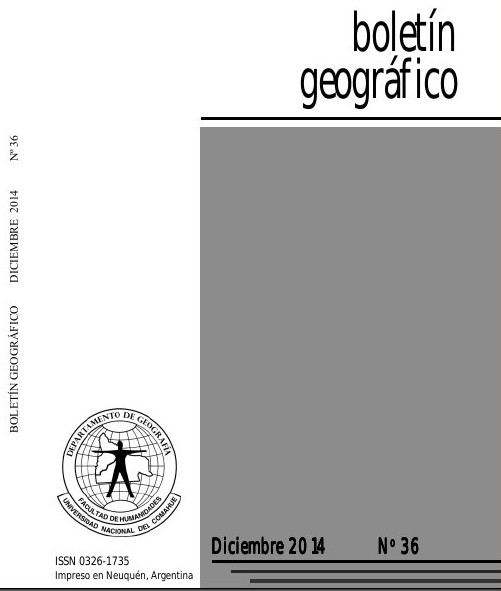A classroom proposal considering the high valley of negro and neuquén rivers region
Keywords:
region, geography teaching, fruit farming, educational contents, annual planningAbstract
Abstract
Within the Postgraduate specialization Educational contents in Geography in National Comahue University, the interest was focused in the study involved North
Patagonia region and the spatial transformations derived from global and national economic restructuring in recent times. The present report presents a collection of contents and geographical themes associated with this area, directed to plan a new annual schedule of geographic classroom contents. The idea behind this proposal was the incorporation of the concept of region, considering the High Valley region of Negro and Neuquén rivers as a study case, and the analysis of fruit farming understood as one of the local production processes which clearly show significant changes in its dynamics as a result of the macroeonomic transformations. The objective is to propose contents which allow middle school students to acquire new knowledge about the North Patagonia region, specifically the Alto Valle region of Río Negro and Neuquén, based on the incomplete study of the region as a cross-curricular theme. This presentation offers a new perspective of thinking about new teaching approaches in the classroom in which students’ everyday life would be considered, specially their own representations of their local sphere as a valid tool to build meaningful and socially relevant knowledge. Geography teaching needs to reconsider to meet students’ demands, to provide tools to offer a solution of their problems and practical needs. The construction of a critical and reflexive subject is essential, and Geography, particularly, assumes a formative and assiduous role, because, through its tools, it intends to realise the student’s intervention, turning himself into an active participant of the construction of his reality.
Downloads
References
AJÓN A. y BACHMANN, L. (2002). El territorio argentino ayer y hoy. Cap. 3: La Argentina en el marco de la globalización. Ed. Longseller. Buenos Aires.
ALBET I MAS, A. (2001) ¿Regiones singulares y regiones sin lugares? Reconsiderando el estudio de o regional y lo local en el contexto de la geografía postmoderna. Boletín de la Asociación de Geógrafos Españoles. Universidad
Autónoma de Barcelona. Departamento de Geografía. Barcelona.
BACHMANN, L. y ACERBI, M. (2002). Sociedades, recursos naturales y ambientes en la Argentina. Ed. Longseller. Buenos Aires.
BANDIERI, S. (2006). La Patagonia: Mitos y realidades de un espacio social heterogéneo, en Jorge Gelman, comp., La Historia Económica Argentina en la encrucijada: Balances y perspectivas. Buenos Aires, Asociación Argentina de Historia Económica-Prometeo Libros. pp. 389-410.
BENDINI, M.; STEIMBREGER, N y RADONICH, M., (2003). Expansiones de frontera agrícola y transformaciones territoriales: procesos sociales diferenciales en BENDINI, M y STEIMBREGER, N (2003) (coord.) Territorios y organización social de la agricultura. Cuadernos del GESA 4. La Colmena. Buenos Aires.
DE JONG, G. (2001). Introducción al método regional. LIPAT- Laboratorio patagónico de investigación para el ordenamiento ambiental y territorial. Departamento de Geografía. Facultad de Humanidades. Universidad Nacional del Comahue. Neuquén, Argentina.
GONZÁLES, S. (2005). La geografía escalar del capitalismo global. Scripta Nova, Revista Electrónica de Geografía y Ciencias Sociales, 189. http://www.ub.ges/geocrit/sn-189-htm
HARVEY, D. (1994). The Social Construction of Space and Time. A relational theory. Geographical Review of Japan, Vol. 67 (2), pp.126-135.
KLOSTER, E. (1995). Las colonias agrícolas y los vaivenes de la fruticultura. En Neuquén, una Geografía abierta. Universidad Nacional del Comahue. Grupo Hache, Impresores, Editores. Buenos Aires.
PEREYRA, J; PEREYRA, Dl. (2008). De bardas, ríos y murallas. Documental. Otro Mundo Documentales. Producción independiente. Neuquén.
SVAMPA, M. (2004). La brecha urbana. Countries y barrios privados. Capital Intelectual. Buenos Aires. Colección Claves para todos. 111 pág.
Downloads
Published
How to Cite
Issue
Section
License
Copyright (c) 2014 Boletin GeográficoTransfer of rights and data processing
The acceptance of an article for publication in the Journal Geographic Bulletin implies the cession of the rights of printing and reproduction, by any means and means, of the author in favor of the Department of Geography of the National University of Comahue, which will not reject any request reasonable for the authors to obtain permission to reproduce their contributions. The total or partial reproduction of the works published in the Geographic Bulletin must be done citing the origin, otherwise, the copyright is violated.
Likewise, it is understood that the concepts and opinions expressed in each work are the sole responsibility of the author, without being responsible or in solidarity, necessarily, neither the editorial staff nor the editorial staff.
It is the responsibility of the authors to be able to provide interested readers with copies of the raw data, procedure manuals, scores and, in general, relevant experimental material.
Likewise, the Management of the journal guarantees the appropriate treatment of personal data
COPYRIGHT TRANSFER FORM

















 Journal of the
Journal of the 